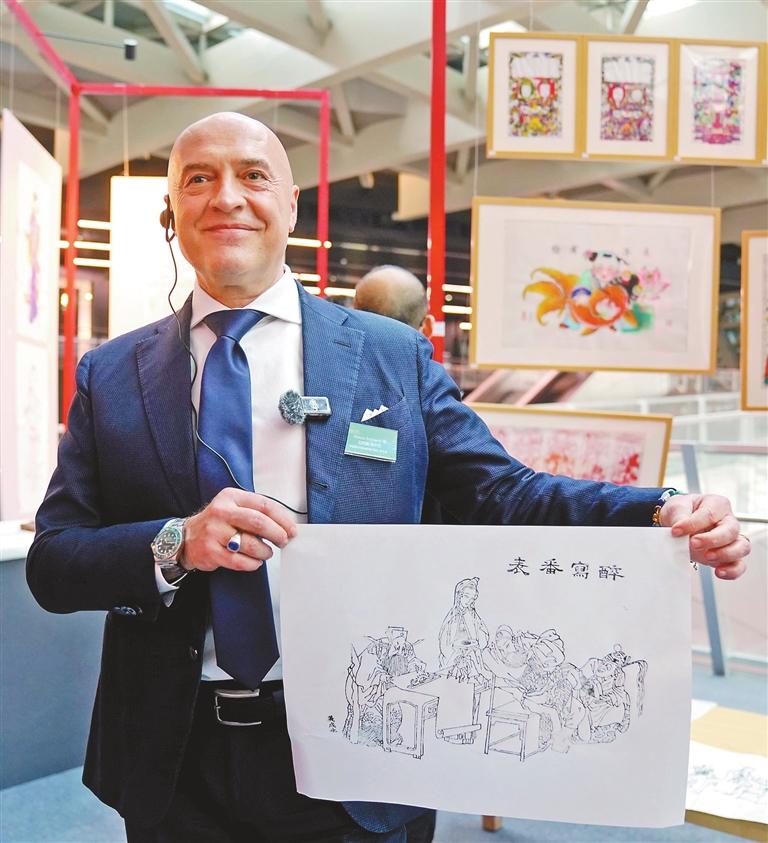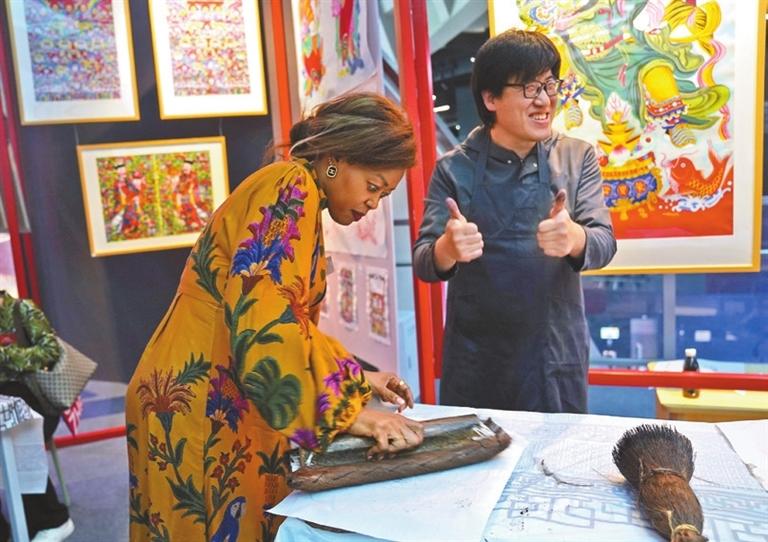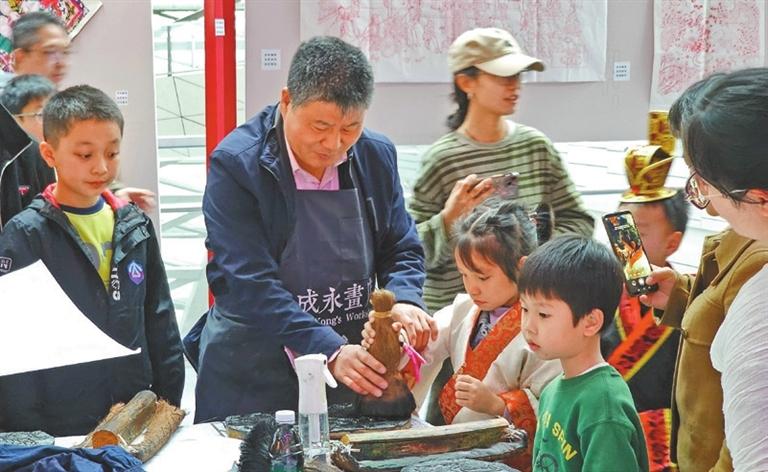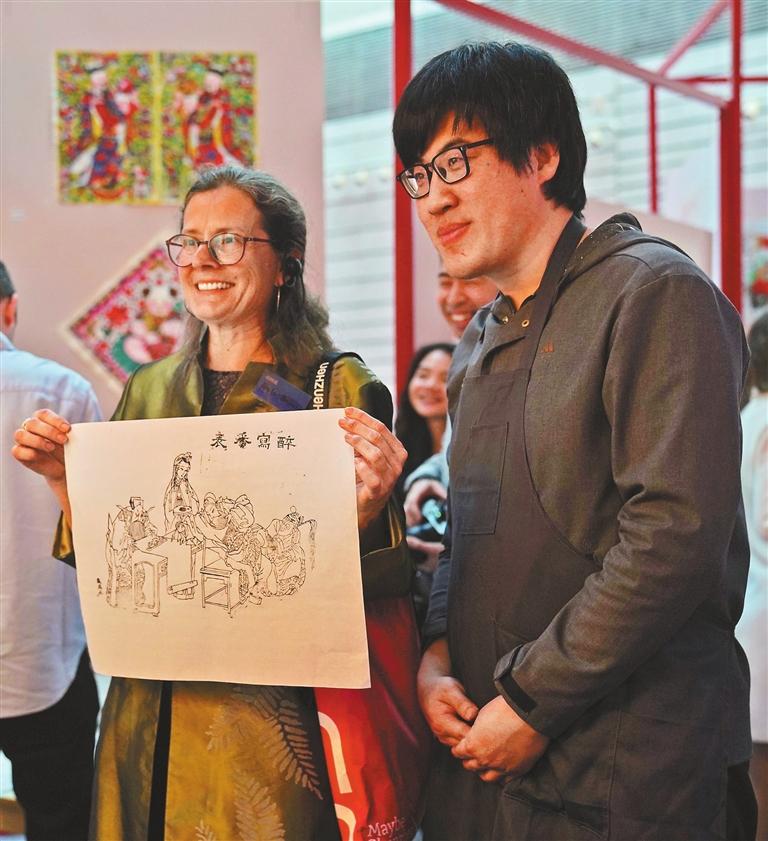




Chen Siqi vankochensq@163.com IN February, during a global gathering of consuls general and representatives from foreign chambers of commerce and institutions based in China, attendees at the Shenzhen Museum of Contemporary Art and Urban Planning were transported into the vibrant world of Yangliuqing woodblock New Year pictures. Guided by Yangliuqing woodblock New Year picture inheritors Yang Peng and Yang Zhongmin, these guests not only marveled at the intricate artistry but also rolled up their sleeves to try their hand at the timeless art form. On the third floor of the museum’s ongoing Guan Gong-themed cultural exhibition, a special section was dedicated to Yangliuqing woodblock New Year pictures. The exhibition featured around 40 pieces created by artists from the Yichengyong Picture Studio in northern China's Tianjin. The artworks depicted Guan Gong, a prominent historical figure revered for his loyalty, bravery, and righteousness, perfectly aligning with the exhibition’s theme. Beyond Guan Gong, the collection also showcased stories of chubby children, goddesses, historical figures, and scenes of daily life. Visitors can also participate in hands-on printing activities during the exhibition. “I hope more people can learn about Yangliuqing woodblock New Year pictures and experience the craft so that we can better inherit and develop this traditional folk art infused with Chinese stories,” said Yang Peng, the eighth-generation inheritor of Yichengyong Picture Studio, which has been dedicated to Yangliuqing woodblock New Year pictures for over a century. Yangliuqing woodblock New Year pictures originated during the Ming Dynasty (1368–1644). These prints, an ancient folk art popular across China, evolved from a reverence for nature and deities to a symbolism used to ward off evil, seek blessings, celebrate festivals, and decorate homes. “Every step must be meticulously executed to create a quality picture,” Yang Peng explained. In 2006, the craft was listed as a national-level intangible cultural heritage. Yichengyong Picture Studio has preserved and promoted this art form since its establishment during Emperor Guangxu’s reign (1875–1908) in the Qing Dynasty (1644–1911). As Yang Peng explained, creating Yangliuqing woodblock New Year pictures involves five main steps: sketching a design, carving it into wooden blocks, printing, hand-painting, and mounting. The artworks are noted for their delicate engraving, fine patterns, vivid figures, and elegant colors. As an inheritor, Yang Peng has lived up to the studio’s legacy. Each year, he creates numerous works with his parents, students, and other helpers. The paintings displayed in the museum are collaborative works by Yang Peng and his parents. He has also worked with curators, experts, industry insiders, and students to promote the craft, organizing exhibitions, publishing books, lecturing at universities, and introducing the tradition to primary and secondary school students. Additionally, he gives public talks during events to popularize the art. Born into an artistic family Born into a family of Yangliuqing artists in 1985, Yang Peng grew up surrounded by the art. From a young age, he watched his grandfather paint, his father carve woodblocks, and his mother make prints. Immersed in this environment, Yang Peng began practicing the craft at the age of 7 while also learning traditional Chinese painting. In addition to inheriting skills from his family, he studied under Yangliuqing artists Wang Huaili and Fang Yinfeng. Yang Peng described mastering the craft as a process of gradual improvement through continuous practice. “I can hold four brushes in one hand simultaneously to paint,” he said, showing the callus on the fourth finger of his right hand and a groove caused by years of holding brushes. He shared an anecdote about a student from the Tianjin Academy of Fine Arts who asked how to achieve his level of skill. He replied, “When your hand looks like mine, you’ll surpass me.” Exploring the world behind the art Despite being born into a Yangliuqing art family, Yang Peng said he didn’t initially feel destined to become an artist. “It’s more like the art chose me rather than me choosing it,” he reflected. “For a long time, I saw it as just a family trade for making a living.” Yang Peng admitted that he was more interested in traditional Chinese painting, but his family background steered him toward Yangliuqing. A turning point came in 2010 when Jiang Yanwen, a curator and expert in Chinese New Year pictures with nearly 20 years of research experience, approached Yang Peng to organize an exhibition featuring works from Yichengyong Picture Studio. To prepare, Yang Peng gathered extensive materials, including physical paintings, craft techniques, and interviews with older generations, gaining firsthand insights into the studio’s history. Through this process, Yang Peng delved deeper into the world of Yangliuqing woodblock New Year pictures, discovering the rich historical and cultural stories behind the art. He gradually came to see inheriting the craft as his life’s mission. The exhibition debuted at the Tianjin Academy of Fine Arts in 2013 and later toured various venues across China. A book on the topic was also published. As Yang Peng learned more about the art, he realized how much there was still to discover. “There’s a vast world behind this craft,” he said. According to Yang Peng, Yangliuqing New Year pictures are more than just decorations for the Chinese New Year — they represent a painting craft that combines traditional techniques from the Song (960–1279) and Yuan (1271–1368) dynasties with woodblock forms from the Ming Dynasty. One of the most iconic images is that of chubby children holding fish, symbolizing blessings for fertility. Another popular theme is the Door Gods, fierce warriors whose portraits are pasted on doors during the Lunar New Year to ward off evil spirits — a tradition dating back to ancient China. “The vivid colors of the New Year pictures bring warmth to homes, especially during the cold, snowy winters in northern China, conveying heartfelt New Year wishes,” Yang Peng said. “That’s why people love them.” Innovative inheritance Over time, the significance of New Year pictures has shifted. While their traditional blessings remain important, they are now valued as gifts, collectibles, and works of art. “The cultural stories behind these paintings deserve to be known by more people,” Yang Peng said. “They are like a folk encyclopedia, reflecting Chinese geography, customs, traditions, and moral values.” To ensure the art’s inheritance and development, Yang Peng believes innovation is key. “Innovation can happen in two ways — through content and form,” he explained. For example, his studio created snake-themed paintings for the Year of the Snake, a departure from traditional imagery. They also collaborated with a gaming company to adapt game characters into Yangliuqing-style artworks and applied traditional motifs to modern products like phone cases, fridge magnets, and coasters. “We also work with schools to introduce students to the craft, planting a seed of interest that may grow in the future,” Yang Peng said. “Through exhibitions at home and abroad, we hope to preserve and develop this traditional Chinese folk art for generations to come.” | 
